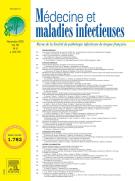Features of anosmia in COVID-19 - 28/07/20
 , N.J. Kadiane-Oussou a, L. Toko a, P.-Y. Royer a, Q. Lepiller b, V. Gendrin a, S. Zayet a
, N.J. Kadiane-Oussou a, L. Toko a, P.-Y. Royer a, Q. Lepiller b, V. Gendrin a, S. Zayet a 
Highlights |
• | Fifty-four of 114 patients (47%) with confirmed COVID-19 reported anosmia. |
• | There is no inpatient cohort about COVID-19-related anosmia in the medical literature. In our study, 37% of our patients were hospitalised. To our knowledge, our study is the main monocentric cohort of confirmed COVID-19 patients with anosmia in France and in the medical literature. |
• | Our data is strong due to a standardised follow-up for non-hospitalised and discharged patients. Patients were called seven days (±7 days) after the first symptoms and every week until recovery (national guidelines recommended a home follow-up for patients with COVID-19). |
• | Our results are similar to the recent multicentric European study conducted by Lechien et al. |
Abstract |
Background |
Medical publications about anosmia with COVID-19 are scarce. We aimed to describe the prevalence and features of anosmia in COVID-19 patients.
Methods |
We retrospectively included COVID-19 patients with anosmia between March 1st and March 17th, 2020. We used SARS-CoV-2 real time PCR in respiratory samples to confirm the cases.
Results |
Fifty-four of 114 patients (47%) with confirmed COVID-19 reported anosmia. Mean age of the 54 patients was 47 (±16) years; 67% were females and 37% were hospitalised. The median Charlson comorbidity index was 0.70 (±1.6 [0–7]). Forty-six patients (85%) had dysgeusia and 28% presented with pneumonia. Anosmia began 4.4 (±1.9 [1–8]) days after infection onset. The mean duration of anosmia was 8.9 (±6.3 [1–21]) days and 98% of patients recovered within 28 days.
Conclusions |
Anosmia was present in half of our European COVID-19 patients and was often associated with dysgeusia.
Le texte complet de cet article est disponible en PDF.Keywords : COVID-19, Anosmia, Dysgeusia
Plan
Vol 50 - N° 5
P. 436-439 - août 2020 Retour au numéroBienvenue sur EM-consulte, la référence des professionnels de santé.

